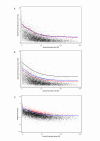The limit fold change model: a practical approach for selecting differentially expressed genes from microarray data
- PMID: 12095422
- PMCID: PMC117238
- DOI: 10.1186/1471-2105-3-17
The limit fold change model: a practical approach for selecting differentially expressed genes from microarray data
Abstract
Background: The biomedical community is developing new methods of data analysis to more efficiently process the massive data sets produced by microarray experiments. Systematic and global mathematical approaches that can be readily applied to a large number of experimental designs become fundamental to correctly handle the otherwise overwhelming data sets.
Results: The gene selection model presented herein is based on the observation that: (1) variance of gene expression is a function of absolute expression; (2) one can model this relationship in order to set an appropriate lower fold change limit of significance; and (3) this relationship defines a function that can be used to select differentially expressed genes. The model first evaluates fold change (FC) across the entire range of absolute expression levels for any number of experimental conditions. Genes are systematically binned, and those genes within the top X% of highest FCs for each bin are evaluated both with and without the use of replicates. A function is fitted through the top X% of each bin, thereby defining a limit fold change. All genes selected by the 5% FC model lie above measurement variability using a within standard deviation (SDwithin) confidence level of 99.9%. Real time-PCR (RT-PCR) analysis demonstrated 85.7% concordance with microarray data selected by the limit function.
Conclusion: The FC model can confidently select differentially expressed genes as corroborated by variance data and RT-PCR. The simplicity of the overall process permits selecting model limits that best describe experimental data by extracting information on gene expression patterns across the range of expression levels. Genes selected by this process can be consistently compared between experiments and enables the user to globally extract information with a high degree of confidence.
Figures


Similar articles
-
Microarray data analysis: a practical approach for selecting differentially expressed genes.Genome Biol. 2001;2(12):PREPRINT0009. doi: 10.1186/gb-2001-2-12-preprint0009. Epub 2001 Nov 16. Genome Biol. 2001. PMID: 11790248
-
The Global Error Assessment (GEA) model for the selection of differentially expressed genes in microarray data.Bioinformatics. 2004 Nov 1;20(16):2726-37. doi: 10.1093/bioinformatics/bth319. Epub 2004 May 14. Bioinformatics. 2004. PMID: 15145801
-
Sample size for detecting differentially expressed genes in microarray experiments.BMC Genomics. 2004 Nov 8;5:87. doi: 10.1186/1471-2164-5-87. BMC Genomics. 2004. PMID: 15533245 Free PMC article.
-
Complementary techniques: validation of gene expression data by quantitative real time PCR.Adv Exp Med Biol. 2007;593:66-73. doi: 10.1007/978-0-387-39978-2_7. Adv Exp Med Biol. 2007. PMID: 17265717 Review.
-
Genetic dissection of gene regulation in multiple mouse tissues.Mamm Genome. 2006 Jun;17(6):490-5. doi: 10.1007/s00335-005-0186-9. Epub 2006 Jun 12. Mamm Genome. 2006. PMID: 16783630 Review.
Cited by
-
Microarray analysis of relative gene expression stability for selection of internal reference genes in the rhesus macaque brain.BMC Mol Biol. 2010 Jun 21;11:47. doi: 10.1186/1471-2199-11-47. BMC Mol Biol. 2010. PMID: 20565976 Free PMC article.
-
A gene network-driven approach to infer novel pathogenicity-associated genes: application to Pseudomonas aeruginosa PAO1.mSystems. 2023 Dec 21;8(6):e0047323. doi: 10.1128/msystems.00473-23. Epub 2023 Nov 3. mSystems. 2023. PMID: 37921470 Free PMC article.
-
Identification of reproducible drug-resistance-related dysregulated genes in small-scale cancer cell line experiments.Sci Rep. 2015 Jul 15;5:11895. doi: 10.1038/srep11895. Sci Rep. 2015. PMID: 26173481 Free PMC article.
-
Transcriptome profiling and pathway analysis of genes expressed differentially in participants with or without a positive response to topiramate treatment for methamphetamine addiction.BMC Med Genomics. 2014 Dec 12;7:65. doi: 10.1186/s12920-014-0065-x. BMC Med Genomics. 2014. PMID: 25495887 Free PMC article. Clinical Trial.
-
Aging-induced alterations in gene transcripts and functional activity of mitochondrial oxidative phosphorylation complexes in the heart.Mech Ageing Dev. 2008 Jun;129(6):304-12. doi: 10.1016/j.mad.2008.02.010. Epub 2008 Mar 4. Mech Ageing Dev. 2008. PMID: 18400259 Free PMC article.
References
-
- Ptashne M, Gann A. Genes & Signals. Cold Spring Harbor, New York: Cold Spring Harbor Laboratory Press. 2002.
-
- Ekins RP. Ligand assays: from electrophoresis to miniaturized microarrays. Clin Chem. 1998;44:2015–2030. - PubMed
Publication types
MeSH terms
Substances
LinkOut - more resources
Full Text Sources
Other Literature Sources
Molecular Biology Databases

